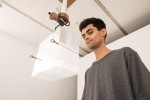Hirad Sab used ten-dollar hardware to holographically render faces on a gallery wall.
With artistic endeavors informed by his background in coding and programming, Sab said he favors digital applications like Blender, an open-source 3D modeling software, over the typical paint palette. His solo exhibition, which opened Tuesday and ends Thursday, features his most recent work, “Disfigure Refigure,” a single installation hosted in the Broad Art Center. In order to create his piece, the graduate design media arts student said he employed the technical skills learned from his computer science degree to explore the technological possibilities of art. He said the interactive nature of his installation forces viewers to contemplate themes – such as surveillance – enfolded within our technological sphere.
“My goal is to push the observer to contemplate their contribution to their data footprint in their day-to-day activities and think about what the data says about you beyond your behaviors, practices and routines,” Sab said. “I want the viewer to see this data as ontologically separate from themselves in the sense that even when you perish, some sort of representation of you still continues and persists.”
Constructed from 64 laser-cut acrylic sheets, “Disfigure Refigure” takes the shape of a cube and hangs from the ceiling by four metal cords. The sheets, overlaid atop each other, form the layered image of a human head. Sab said he attempted to make the head shape as ambiguous as possible when cutting the sheets, allowing visitors’ faces to fit more easily into the framework of the piece. The head is divided into different slices, flattened in order to represent a certain amount of height, similar to the construction of a topographical map.
[RELATED: Inclusive coding event hopes to encourage art, activism in the field]
To complete the three-dimensionality, Sab said he hand-sprayed details onto the sheets for a holographic effect, as the frosted areas restrict the amount of light that can pass through each layer. The face revealed through this trick of lighting incorporates a human aspect into his work through an emphasis on the face’s physiology, said Dalena Tran, a fellow graduate design media arts student.
“(Sab) tries to always enter using very hyperrealistic aesthetics, so I think he wants to go past this uncanny valley to create both a landscape and a context that oftentimes is beyond even what is realistic,” Tran said.
Beyond its aesthetics, Sab’s sculpture works in conjunction with consumer-accessible hardware – specifically, a camera contraption placed directly above the hanging cube. The camera is connected wirelessly to a computer to operate with his code. Sab said he emphasizes that the hardware is easily purchased on sites like Amazon – his computer chip cost $10 and the camera only $5. The sculpture shows the technological and artistic capabilities of hardware that is easily accessible to anyone, he said.
“If you look at art as a type of investigation rather than expression – while I do acknowledge that it can be simultaneously both – it makes perfect sense to make art that is concerned with technology, given how intertwined it is in our daily lives,” Sab said.
To interact with viewers, the system utilizes a face detection algorithm, immersing the viewer into the artwork more fully. The camera uses what is called a certainty value, which detects the likelihood of certain shapes being faces as opposed to miscellaneous objects. It locks onto a particular individual before autonomously deciding to move on to the next one.
[RELATED: UCLA graduate student critiques human interaction with nature in innovative exhibit]
Because the camera is triggered by facial detection, Sab said he is interested in the social interactions provoked by the surveillance aspect of the piece. Individuals can sacrifice their privacy by purposely attracting the camera’s gaze and diverting attention from others. Interaction with the software aims for greater reflection on part of the viewer, particularly on the body’s use as a control element, said Lauren McCarthy, an assistant professor of design media arts.
“It’s a voyeuristic experience where you’re directly manipulating the projection, whether intentionally or unintentionally,” McCarthy said. “The viewer is positioned within the media, causing them to reflect on what their role in (the installation) was.”
By detecting the individuals’ presence and projecting their faces onto the sculpture, Sab said his piece is ultimately meant to embody an experience that integrates the viewer as a facet of the art itself. This sense of interactive immersion takes the piece beyond the surface-level visual aesthetic, he said.
“The audience should question some fundamental aspect of reality,” Sab said. “In this piece, my conversation primarily revolves around us as these digital entities being constantly fragmented and molded back again, able to continue and to not necessarily leave a trace, but to be a trace of us.”
